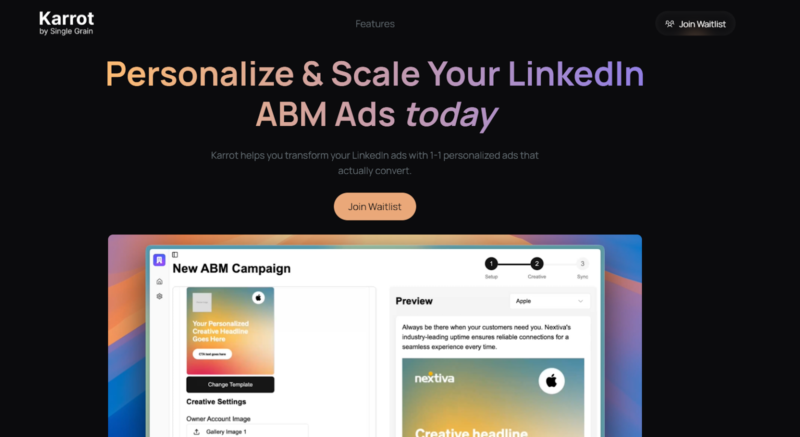Essential Pre-Campaign Strategies for LinkedIn ABM Success
The success of any LinkedIn account-based marketing (ABM) campaign is largely determined before the first ad is ever launched. While many marketers focus their attention on campaign execution and optimization, the pre-campaign strategy phase is where the foundation for exceptional results is established.
Marketers can significantly improve overall campaign performance by answering simple questions about their target accounts and how they will build their ABM team. Here are the essential pre-campaign strategies to engage and convert high-value accounts on LinkedIn.
Key Highlights
- Effective pre-campaign strategies can improve LinkedIn ABM performance by up to 65%.
- 97% of marketers report that ABM delivers a higher return on investment than other marketing strategies.
- Data-driven account selection increases targeting precision by 45-55%.
- Buyer journey mapping ensures content and messaging alignment with the decision process.
- Cross-functional alignment between marketing and sales is essential for campaign success.
- AI-powered tools like Karrot.ai can streamline pre-campaign preparation and improve results.
- A comprehensive tracking setup enables accurate measurement of campaign impact.
- Pilot testing with a subset of accounts can validate the approach before full deployment.
TABLE OF CONTENTS:
The Strategic Foundation of LinkedIn ABM
ABM is more than just acquiring new clients and increasing revenue. This strategy aims to establish and build relationships with high-quality leads. LinkedIn is one of the best places to host an ABM campaign; professionals use this platform for networking, and businesses can access exceptional targeting features in one place.
However, the difference between average and exceptional LinkedIn ABM campaigns often lies in the quality of pre-campaign strategy work..
The Pre-Campaign Strategy Framework
In the pre-campaign phase, ABM marketers set clear objectives and plan the individual tactics to accomplish these goals. Many marketers also include other best practices, such as which metrics to measure and how often.

A comprehensive pre-campaign strategy consists of seven interconnected components:
- Strategic alignment: Connecting ABM objectives to business goals.
- Account intelligence: Developing deep account understanding.
- Audience architecture: Building precise targeting frameworks.
- Message development: Creating compelling, personalized messaging.
- Content strategy: Mapping content to the buyer journey.
- Technology configuration: Setting up the necessary tech stack.
- Measurement planning: Establishing clear success metrics.
These seven components in your pre-planning can increase brand relevance and targeting precision.
Strategy 1: Establish Clear Strategic Alignment
Before launching any LinkedIn ABM campaign, establish precise alignment between campaign objectives and broader business goals. This will make your campaign more effective and efficient. Here’s how it’s done.
Objective Hierarchy Development
Create a clear hierarchy of objectives, such as this one:
| Level | Example | Purpose |
|---|---|---|
| Business Objective | Increase enterprise revenue by 25% | Define ultimate business impact |
| Marketing Objective | Generate $10M in pipeline from target accounts | Connect marketing to business outcomes |
| Campaign Objective | Engage 70% of target accounts, convert 15% to opportunities | Set specific campaign goals |
| Tactical Objectives | Achieve 3% CTR, 40% landing page conversion | Define execution metrics |
This hierarchical approach ensures LinkedIn ABM campaigns are designed to deliver business impact rather than just marketing metrics.
Cross-Functional Alignment
Your sales and marketing teams should join forces to accomplish your ABM goals. You can also establish alignment across these other roles:
- Executive sponsors: Secure leadership buy-in and support.
- Sales leadership: Ensure sales strategy alignment.
- Marketing team: Align with broader marketing initiatives.
- Content creators: Brief on account-specific requirements.
- Analytics team: Establish measurement approach.
Companies with strong cross-functional alignment are 67% more likely to exceed revenue goals, making this a critical success factor for LinkedIn ABM.
Resource Allocation Framework
Develop a transparent resource allocation model for decision making. Here’s an example framework:
Resource Allocation:
– Tier 1 Accounts (20% of list): 50% of budget and resources.
– Tier 2 Accounts (30% of list): 30% of budget and resources.
– Tier 3 Accounts (50% of list): 20% of budget and resources.
This tiered approach ensures resources are allocated according to potential account value rather than spread evenly across all targets.
Strategy 2: Conduct Comprehensive Account Research
Researching your ideal accounts and preparing a targeting strategy are essential for ABM. Here’s how to gain this insight,
Account Research Framework
Implement a systematic research approach, such as this one:
- Company overview: Size, structure, business model, recent performance.
- Industry context: Sector trends, challenges, competitive landscape.
- Strategic initiatives: Published priorities, expansion plans, transformation efforts.
- Technology landscape: Current stack, recent implementations, planned changes.
- Decision-making structure: Key stakeholders, buying process, approval patterns.
This structured research provides the insights needed for personalization and to drive engagement.
Buying Committee Mapping
Map the complete buying committee within each target account. Use this guide as an example:
- Economic buyers: Those who control the budget and make final decisions.
- Technical evaluators: Those who assess solution capabilities.
- End users: Those who will use the solution day-to-day.
- Influencers: Those who shape opinions but don’t make decisions.
- Gatekeepers: Those who control access to other stakeholders.
It’s also helpful to know whether these roles will change at each phase of the sales funnel. Always engage with 10% of your team to cover all key buying committee members.
Account Insights Database
Create a centralized repository of account insights. Here are the roles to include:
- Account profiles: Comprehensive summaries of key information.
- Stakeholder maps: Visual representations of buying committees.
- Opportunity assessments: Evaluation of potential deal size and timing.
- Competitive positioning: Analysis of competitive dynamics.
- Historical interactions: Record of previous engagement.
This knowledge base ensures all team members have access to consistent, comprehensive account information throughout the campaign.
Strategy 3: Develop a Sophisticated Audience Architecture
Moving beyond basic account lists to sophisticated audience architecture significantly improves targeting precision. This ensures you tailor your marketing strategies to each individual’s unique needs. Here’s how to do it.
Multi-Dimensional Segmentation
Segment your accounts if you’re working with large datasets. Implement advanced segmentation approaches, such as these:
- Value-based segmentation: Grouping by potential opportunity size.
- Need-based segmentation: Clustering by primary challenges and pain points.
- Readiness segmentation: Categorizing by buying stage and timing.
- Relationship segmentation: Segmenting by existing relationship strength.
- Engagement segmentation: Grouping by historical engagement patterns.
This multi-dimensional approach ensures messaging is relevant to the account and their situation.
LinkedIn Audience Construction
Build sophisticated LinkedIn audiences to improve targeting. Here are some features that LinkedIn offers:
- Company targeting: Upload account lists via LinkedIn’s Matched Audiences.
- Contact targeting: Upload known contacts within target accounts.
- Lookalike expansion: Extend reach to similar accounts and roles.
- Website retargeting: Capture account visitors for remarketing.
- Engagement retargeting: Retarget users who engaged with previous content.
Companies implementing AI-enhanced audience development strategies report 38% higher engagement rates than basic targeting approaches.
Audience Validation Process
Before launching campaigns, validate audience quality. Use these tactics to gauge this:
- Coverage analysis: Ensure sufficient reach within target accounts.
- Role distribution: Verify appropriate stakeholder coverage.
- Engagement potential: Assess likelihood of response based on previous patterns.
- Competitive exposure: Identify accounts that also engage with competitors.
- Sales alignment: Confirm sales team validation of priority accounts.
This validation process ensures marketing resources are focused on audiences with the highest potential for engagement and conversion.
Strategy 4: Create a Compelling Messaging Framework
After identifying your target audience and developing your unique audience personas, you must craft a unique selling proposition (USP) that fits their needs. Effective messaging is the bridge between account understanding and campaign execution. Here’s how it works.
Value Proposition Matrix
Develop a matrix of value propositions that lists customer wants, needs, and pain points, as well as how you will offer your benefits and solutions to them. Here’s an example of an account matrix:
| Segment | Primary Pain Point | Value Proposition | Key Messaging Themes |
|---|---|---|---|
| Financial Services | Regulatory compliance | Automated compliance reporting | Risk reduction, audit readiness |
| Healthcare | Patient data fragmentation | Unified patient records | Care coordination, outcome improvement |
| Enterprise | System complexity | Simplified architecture | Operational efficiency, cost reduction |
| Mid-Market | Resource constraints | Efficient operations | Productivity, competitive advantage |
This structured approach ensures messaging is systematically aligned with segment-specific needs rather than generically applied.
Personalization Framework
Establish a scalable framework for personalized messaging that will bring long-term results. Here’s what to include in your framework:
- Account-level personalization: Company name, industry, challenges.
- Role-based personalization: Different messaging for various stakeholders.
- Stage-based personalization: Content aligned with the buying stage.
- Behavioral personalization: Messaging based on previous interactions.
- Intent-based personalization: Content addressing demonstrated interests.
Message Testing Protocol
Develop a systematic approach to message testing and include these steps:
-
- Internal review: Validation with subject matter experts.
- Sales feedback: Input from customer-facing teams.
- Customer validation: Testing with friendly customers.
- Small-scale testing: Test the success of one variable.
- Leverage feedback: Include both quantitative and qualitative.
- Iterative refinement: Continuous improvement based on results.
This testing protocol ensures messaging is validated before full-scale deployment, significantly improving campaign performance.
Strategy 5: Map Content to the Buyer Journey
There are three main buyer journey stages: awareness, consideration, and decision. Your content strategy should include targeting for all these stages. Here’s how to do it.
Buyer Journey Mapping
When creating your buyer journey map, include the thoughts, questions, and actions a buyer will experience at every stage. Here’s a sample map:
Awareness Stage
- Key questions: “What challenges are we facing? Are others experiencing this?”
- Information needs: Industry trends, challenge validation, and peer perspectives.
- Content types: Thought leadership, industry reports, trend analysis.
Consideration Stage
- Key questions: “What approaches exist? How do they compare?”
- Information needs: Solution approaches, methodology overviews, comparison frameworks.
- Content types: Solution guides, methodology explanations, comparison tools.
Decision Stage
- Key questions: “Why this solution? What results can we expect?”
- Information needs: Implementation details, ROI analysis, proof points
- Content types: Case studies, ROI calculators, implementation guides.
This journey mapping ensures that content is aligned with prospects’ questions and needs at each stage rather than focusing solely on product features.
Content Audit and Gap Analysis
A content and gap analysis takes buyer journey targeting further while auditing your existing strategy. Follow these steps to assess existing content:
- Inventory existing content and map to journey stages.
- Identify gaps where content needs don’t match available assets.
- Prioritize content creation based on campaign needs.
- Develop new assets to fill critical gaps.
- Optimize existing content for personalization.
This systematic approach ensures content resources are allocated to the most essential touchpoints rather than creating assets without strategic direction.
Personalization Strategy
Content personalization ensures all your messaging will turn into meaningful conversations. Use these tips to develop a strategy for content personalization:
- Modular content design: Creating components that can be recombined.
- Dynamic content insertion: Automated personalization of key elements.
- Account-specific examples: Customized use cases and scenarios.
- Industry-specific versions: Tailored variations for different sectors.
- Role-based perspectives: Different angles for various stakeholders.
When companies address client intent, they achieve a higher revenue of up to 40% compared to generic messaging.
Strategy 6: Configure Your Technology Stack
A properly configured technology stack is essential for campaign execution and measurement. Here are some of the best ABM tools.
Core Technology Components
Ensure these essential technologies are in place:
- CRM system: Central database for account and contact information.
- Marketing automation: Orchestration of multi-touch engagement.
- LinkedIn advertising platform: Campaign execution and management.
- ABM platform: Account targeting and engagement tracking.
- Analytics solution: Performance measurement and attribution.
- Personalization engine: Dynamic content delivery across touchpoints.
The integration of these technologies creates a unified data flow that connects all stages of the ABM pipeline.
Data Integration Requirements
Implement these critical data connections:
- LinkedIn Lead Gen Forms → CRM: For seamless lead capture.
- LinkedIn Insight Tag → Website Analytics: For visitor identification.
- CRM → LinkedIn Matched Audiences: For audience synchronization.
- Engagement Data → Marketing Automation: For behavior-based nurturing.
- Opportunity Data → Attribution System: For revenue connection.
The Karrot.ai Advantage

Platforms like Karrot.ai can significantly enhance pre-campaign preparation through:
- Automated account research that gathers and organizes key information
- AI-powered audience development that identifies optimal targeting approaches
- Personalized creative generation that scales across hundreds of accounts
- Dynamic content optimization based on engagement patterns
- Integrated performance tracking that connects activities to outcomes
Strategy 7: Establish Comprehensive Tracking
Robust measurement planning is a critical pre-campaign activity. Here’s how to plan your metrics and KPIs.
Multi-Level Measurement Framework
Implement a structured measurement approach, such as this graph:
| Metric Level | Example Metrics | Purpose |
|---|---|---|
| Activity Metrics | Impressions, clicks, engagement | Measure campaign execution |
| Response Metrics | Account engagement, content downloads | Measure target account response |
| Impact Metrics | Pipeline influence, revenue contribution | Measure business outcomes |
| Efficiency Metrics | Cost per acquisition, ROI | Measure program efficiency |
This multi-level approach ensures you track leading indicators (activity and response) and lagging indicators (impact and efficiency) to get a complete picture of campaign performance.
Attribution Model Selection
There are different attribution models you can measure. Select the appropriate attribution approach for your goals:
- First-touch attribution: Credits the first touchpoint that engaged the account.
- Last-touch attribution: Credits the final touchpoint before conversion.
- Multi-touch attribution: Distributes credit across all touchpoints.
- Position-based attribution: Weights credit based on touchpoint position.
- Time-decay attribution: Gives more credit to recent touchpoints.
Tracking Implementation
Implement these essential tracking elements:
- LinkedIn Insight Tag: For website visitor identification.
- UTM parameters: For source and campaign tracking.
- Landing page tracking: For conversion monitoring.
- CRM campaign objects: For opportunity attribution.
- Custom event tracking: This is for specific interaction measurement.
This comprehensive tracking implementation ensures all campaign activities can be connected to business outcomes, providing the data needed for optimization and ROI calculation.
Strategy 8: Conduct Pilot Testing
Before full deployment, validate your approach through pilot testing. Here’s how to do it.
Pilot Program Design
Structure a focused pilot program that includes these elements:
- Select a representative subset of target accounts (10-15%).
- Include accounts from different segments to test various approaches.
- Implement the complete campaign strategy at smaller scale.
- Establish clear success criteria for evaluation.
- Set a defined timeframe for assessment (typically 4-6 weeks).
This pilot approach allows for validation and refinement before committing complete resources to the campaign.
Rapid Learning Cycle
Implement an accelerated learning process by following these steps:
- Daily performance monitoring: Track key metrics in real-time.
- Weekly analysis sessions: Identify patterns and opportunities.
- Bi-weekly optimization: Make adjustments based on findings.
- End-of-pilot assessment: Comprehensive evaluation against criteria.
- Strategy refinement: Update approach based on pilot learnings.
This structured learning process ensures insights are quickly incorporated into the campaign strategy before full deployment.
Scale-Up Planning
Develop a systematic approach to scaling successful elements using these tips:
- Prioritize high-performing tactics for broader implementation.
- Refine underperforming elements based on pilot learnings.
- Adjust resource allocation based on observed results.
- Update timeline and expectations for the full campaign.
- Brief all stakeholders on pilot outcomes and revised approach.
This methodical scale-up planning ensures successful elements are expanded while challenges are addressed before full deployment.
Case Study: Tech Company Transforms Results with Strategic Preparation
A B2B software company implemented comprehensive pre-campaign strategies for their LinkedIn ABM program targeting 500 enterprise accounts. By investing in thorough preparation, they:
- Developed a data-driven account selection model that improved targeting precision by 64%.
- Created detailed buying committee maps for their top 100 accounts.
- Implemented multi-dimensional segmentation across industries and buying stages.
- Developed personalized messaging frameworks for different stakeholders.
- Mapped content to the complete buyer journey and filled critical gaps.
- Configured an integrated technology stack with closed-loop reporting.
- Conducted a 6-week pilot with 50 accounts before full deployment.
The results demonstrated the power of strategic preparation:
- 187% increase in target account engagement compared to previous campaigns
- 64% improvement in MQL-to-opportunity conversion
- 42% reduction in cost-per-acquisition
- 3.2X return on ad spend
- $14.7M in influenced pipeline within 6 months
- 28% shorter sales cycles for engaged accounts
Best Practices for Pre-Campaign Success
To maximize the effectiveness of your LinkedIn ABM pre-campaign strategies, follow these proven best practices:
- Start with precise business alignment to ensure campaign goals connect to revenue outcomes
- Invest in deep account research rather than relying on surface-level information
- Develop multi-dimensional segmentation beyond basic firmographic categories
- Create messaging frameworks that systematically address segment-specific needs
- Map content to the complete buyer journey rather than focusing on product features
- Implement comprehensive tracking before launching any campaign activities
- Validate your approach through pilot testing with a representative subset of accounts
- Leverage AI-powered tools like Karrot.ai to enhance preparation without increasing workload
- Maintain cross-functional alignment throughout the preparation process
- Document your strategy to ensure consistent execution across teams
Use These Essential Pre-Campaign Strategies for ABM Success
Your ABM efforts should start with these essential pre-campaign strategies. Pre-campaign strategies include everything from sales and marketing alignment to pilot testing, and marketers can use this to significantly improve targeting precision, message relevance, and overall campaign results.
When creating an ABM strategy, marketers should focus on more than ROI and revenue. The key is setting precise goals and preparing rather than rushing to campaign execution. Tools like Karrot.ai can streamline the preparation process while enhancing the sophistication of your approach.
When marketers combine strategy with AI-powered capabilities, they can create LinkedIn ABM campaigns that deliver exceptional results.




